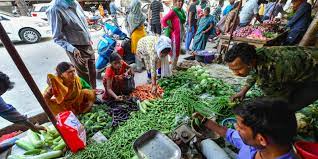The CPI Inflation Rate Increases To 7.44% In July Due To Soaring Vegetable Prices
Data on inflation from the Consumer Price Index (CPI) were published on August 14 and revealed that retail inflation reached 7.44 percent in July. For the first time since February 2023, retail inflation has exceeded the RBI’s tolerance zone of 2–6%.
The CPI inflation rate for July, 7.44 percent, is also the highest since the peak of 7.79 percent for retail inflation in April 2022. The Ministry of Statistics and Project Implementation figures show that the category for vegetables saw the largest year-over-year inflation. In July, it was 34.64 percent.
When the headline figure fell to 4.2% in May, inflation had already begun to slow down earlier this year. But in June, pressure from growing food costs began to weigh on the figure, pushing up the inflation rate to 4.8%.
The Reserve Bank of India (RBI) has retained the repo rate at 6% while keeping a watch on food inflation. RBI Governor Shaktikanta Das said in a statement after the completion of the monetary policy meeting that the central bank has increased its prediction of CPI inflation for this fiscal to 5.4% from the prior forecast of 5.1%. Given the ongoing uncertainty, we have updated our most recent CPI inflation predictions for 2023–24 to 5.4%, with Q2 at 6.2%, Q3 at 5.7%, and Q4 at 5.2%, assuming a normal monsoon. CPI inflation is anticipated to be 5.2% in Q1:2024–2025. The governor had claimed that the risks were fairly distributed.
Amnish Aggarwal, Head of Research at Prabhudas Lilladher, responded to the RBI’s projection by stating, “If the forecast for CPI inflation for coming quarters holds, then I think there will be a delay in the revival in consumer demand that people are expecting for FMCG companies.”
According to the most recent CPI statistics, rural regions had greater rates of inflation than urban areas, reversing patterns from the previous month. Due to poor demand in rural regions, FMCG firms have been struggling with slow volume growth. The information for the two prior quarters, however, indicated that the illusive volume increase was returning as a result of declining inflation and increasing disposable income. Analysts had issued a warning, however, that any pressure on inflation would pose a challenge for the rebound in consumer demand.
According to Anand Rathi Shares and Stock Brokers’ Chief Economist and Executive Director Sujan Hajra, the CPI inflation figure is higher than anticipated. “Given that the increase was far bigger than anticipated, we doubt that inflation will resume its glide path any time soon. Given this context, the RBI raising rates by another 25 basis points is definitely a possibility. A rate drop in the next year, he said, “appears extremely unlikely.”
The present pressure on inflation, according to Dipti Deshpande, Principal Economist of CRISIL Limited, “seemed transitory.” After a few more months, government action and the advent of new crops should stop the rise in food prices, she said.
The government also disclosed the wholesale pricing index (WPI) inflation figures earlier in the day. The official figures show that although WPI inflation stayed in the deflationary zone, food prices increased. Food inflation climbed to 7.75% in July from -1.24% in June, according to data. During the preceding month, the inflation rates for manufactured goods, gasoline, and electricity were deflationary.
The increase in vegetable costs was the main factor behind the increase in food prices. According to the statistics, vegetable costs increased by 62% from one year to the next. Rajani Sinha, the chief economist at CareEdge Ratings, commented on the patterns in the WPI statistics, stating that “if food prices continue to trend upward, the deflationary trend could end, and WPI inflation could turn slightly positive in the coming months.” Additionally, an upside risk to the prognosis is posed by the upward trend in global crude oil prices, worldwide edible oil prices, and locally unequal monsoon distribution.







